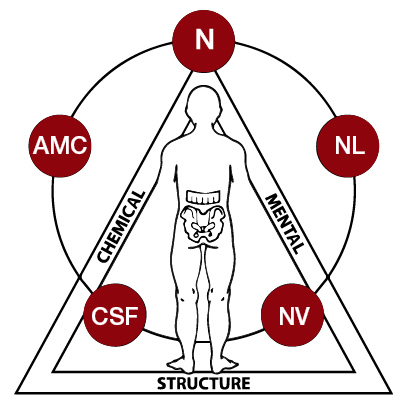What is Applied Kinesiology?
What is Applied Kinesiology?
Applied Kinesiology (AK) is a chiropractic technique used to diagnose underlying or hidden problems within a patient by way of manual muscle testing. This non-evasive technique can evaluate mechanical, nutritional / chemical, and mental / emotional / spiritual stresses in the body.
Mechanical Stressors
Mechanical stress is when movement in a joint or muscle causes undue stress in the nervous systemMechanical
Stress Can Be...
- Joint Subluxations (“bone out of place”)
- Trigger points in muscles
- Muscle imbalances
- Meridian / Energy flow imbalances
- Poor posture
- Poor gait pattern (the way you walk)
Nutritional & Chemical Stress
Without the proper nutrition and avoidance of toxins, it can lead to problems with how the body can handle stressThis includes
- Vitamin & mineral deficiencies
- Hormone imbalances
- Energy production problems
- Inability to get rid of toxins
- Decreased immune function leading to
- Candida overgrowth
- Parasite take over
- Bacteria build up
- Viral susceptibility
Mental & Emotional Stress
Emotions play a large role in how our bodies function, perceive pain, and handle day to day stressThis can...
- Decrease the function of organs
- Create muscle imbalances
- Block meridian/energy flow
- Create pain loops
- Be linked to childhood traumas
- Sometimes hurt the people around us

Why go to an AK Doctor ?
Why Go To an AK Doctor?
Applied Kinesiology practitioners will examine more than the joints in the body and spine to find the solution to a patient’s problem(s). Pain is the number one complaint in a chiropractic office and sometimes that pain isn’t related to a subluxation. There are pain referral patterns for organs and trigger points in the muscles that are often the source of people’s pain. AK looks to address these and more.
The Triad of Health
In Applied Kinesiology, we have what is called the “Triad of Health”. We have 3 sides of the triangle and without a single side, a triangle cannot stand. We have the 2 sides, chemical and mental, but at the base we have structural. The structure is what each chiropractor addresses but if the patient doesn’t have a doctor or doctors addressing the chemical and mental sides, full health potential cannot be achieved.
What does the chemical side include?
- Well balanced diet: One that does not trigger the inflammatory system, immune response, or histamine production.
- Address vitamin deficiencies: Lacking certain vitamins will lead to many processes in the body to not function as they were designed. These functions can lead to fatigue or low energy, suppressed immune function, decreased hormone production, poor digestion, and increased pain sensitivity.
- Avoidance of toxic chemicals: This include perfumes, scents (not essential oils), cleaning solutions, pesticides, and other environmental toxins.
What does the mental side include?
- Taking care of your mental health: This means addressing past or childhood traumas, learning how to handle and cope with daily emotions and stressors, and avoiding triggers in your life.
- Spiritual: This side also deals with how in touch someone is with their spiritual side. This could include meditation or being more involved in a religion and prayer.


Structure is the foundation of the triangle
There are two main components that make up our structure.
- Bones + ligaments
- Muscles + tendons
Applied Kinesiology addresses these in a number of ways:
- Chiropractic adjustment: This helps to align your spine and extremity joints by freeing up anything (subluxations) hindering brain signals going to the muscles from the brain and the signals sent from the muscles to the brain. Think of this removing interference in those signals.
- Trigger point therapy: Muscles move bones but what happens when a muscle isn’t functioning correctly? It can cause those subluxations. Addressing trigger points in muscles can help prevent recurring subluxations.
- Gait pattern: This is how the body moves in a walking or running state. Addressing the gait and correcting poor gait patterns can prevent injuries and recurring subluxations.
- Posture: Many people have poor posture. This causes an over activation of certain muscle groups, leading to the opposing groups to deactivate. Posture, at first, is a conscious effort but when coupled with exercise, it can become natural.
- Exercises: Prescribing specific exercises to address imbalanced muscle groups can help the stimulation of the brain signals that the adjustments help. The end result: chiropractic adjustments hold for longer.
The Applied Kinesiology Examination
What you can expect during an AK initial visit
Dr. Bartlett has the patient sit to discuss their history and intake form to learn why they are coming in. The history and information on the intake form can give clues as to what is going on, why it is happening, and sometimes the event or events that led to the current situation.
After the history, the patient will lay down on the table. Utilizing AK muscle testing, Dr. Bartlett will begin by taking a muscle and having the patient meet his resistance (pushing against his hand). Once a baseline is determined, the muscle testing exam can include any of the following based on the individual patient:
- Neurologic testing
- Organ reflex association testing
- Muscle tests for weaknesses, trigger points, and imbalances
- Nutritional deficiency testing
- Hormone balance testing
- Energy balance testing
- Genetic testing
- And spinal and joint alignment testing
The muscle testing will determine the route of treatment for that individual patient. The treatments for any of the above that is identified could include:
- Chiropractic adjustment to realign the spine and joints to allow for proper nerve signal flow throughout the body
- Reflexology, which is the stimulation of specific points on the body that has been found to relate to specific organs and muscles in the body
- Acupressure to properly balance energy and meridian flow to all the organs and muscles in the body
- Vitamin suggestions to address vitamin deficiencies, homeopathic remedies, or herbal/endocrine blends to help stimulate biochemical pathways or enzymatic processes to strengthen the body and increase its’ healing potential
- Prescribing specific exercises to help hold the adjustments and bring the body into a better balance
- Diet recommendations to address the foods that may be causing an inflammatory or immune reaction or an increase in the histamine (allergy) response
Typically, Dr. Bartlett likes to see new patients once per week. In rare or acute cases, this may be 2-3x per week. The typical weekly visits are needed to see recurring patterns and address underlying issues as the surface issues resolve. The week between visits are to allow the body to go through the healing processes and will be reassessed on each subsequent visit. The goal is to get the patient well enough to only see a couple times a year for a “tune up”, to ensure new problems do not become chronic, long lasting problems.
